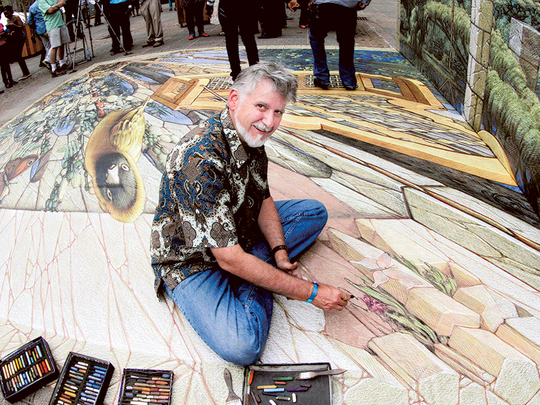
Dubai: Renowned street artist Kurt Wenner traded his workspace at Nasa for the streets in 1982, his drawings of spaceships for classical art, and his purely scientific audience for the general public. He has not looked back since.
“For me, the most rewarding aspect of pavement art has been the joy it gives to the public,” the American artist told Gulf News.
Pavement art makes use of flat surfaces such as pavements or streets as the canvas. It is painted live outdoors and away from the traditional four corners of art galleries to allow the public to experience the artwork as it unfolds.
This view of Wenner is slowly being realised in Dubai as it strives to transform Dubai into an open-air museum. Wenner is now in Dubai for the inaugural Dubai Canvas, a festival celebrating art and culture with three-dimensional (3D) pavement art as the chosen theme this year.
Wenner invented 3D pavement art in 1984 as a way to bring the tradition of European classical drawing into a contemporary public space — the street. It makes use of a ‘trick’ image or composition that, when drawn on a flat surface, creates an illusion of being three-dimensional from a certain angle.
But how is it done? Wenner said a bit of maths is involved in that one needs to first consider the shape or geometry of the piece and the scale of the project.
“I map out the position of the viewer and the size of the work. I then create an architectural framework that holds the image,” Wenner said.
Then he works with two versions of the image — a perspective view that shows how the camera or the viewer will see the image and a plan view that shows how it will be drawn and painted. And, somewhere along the way, the two versions come together to create a three-dimensional piece that appears to rise from or fall into the ground.
Wenner started with classical art as his main subject. As the years went by, Wenner began incorporating his audiences into his work.
“Eventually, the public became very interested in posing on and around the works and I began to compose works with that idea in mind. This became known as interactive 3D pavement art,” Wenner said.
And now, with the increasing use of social media, the interactive aspect has become central to the art form.
“I then developed new techniques to allow for the public to stand or sit on the art without disturbing the image. I also began to work with multiple surfaces, such as walls and ceilings.”
3D pavement art is challenging to artists because it is exposed to the elements such as rain, sunlight, dust, and wind, that could damage or affect the painting while it is in progress. The environment may also be noisy and distracting.
“Many works which may invite contemplation in the protected space of a gallery would never hold up in an outdoor public space,” Wenner said.
Because street painting is a performance art, the artwork is almost always impermanent. But it’s the visual impression created in the public’s minds that give him the biggest satisfaction as an artist.
“Sometimes I wish for the kind of sanctification that a gallery or museum lends to artwork, but I realise that most of those works never reach the vast audience that I enjoy, nor influence the number of young artists.”








